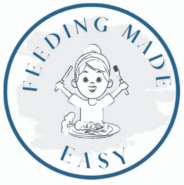Milk allergy is the most common allergy in infants and young children, affecting around 2.5% of children under the age of 3 (1). There are actually 2 categories of milk allergies: IgE mediated and non-IgE mediated. We often see non-IgE mediated milk allergy in young infants and many will outgrow it by their first birthday. This article, however, will be focusing on IgE mediated milk allergy.
When a person with milk allergy is exposed to the proteins in milk, the proteins bind to IgE antibodies that trigger the immune system, causing a reaction. Up to 70% of children with this allergy can tolerate milk baked into foods (2). Once the milk has been heated, it changes the structure of the protein enough so that the body doesn’t respond to it. Tolerating baked milk while young is a good sign that a child may outgrow their milk allergy. Up to 75% of children will outgrow their milk allergy (3).
This post may contain affiliate links and when you click on the links I may earn a small commission at no charge to you. As an Amazon affiliate, I earn a commission from qualifying purchases.
How to Introduce Milk
As with other allergens, introduce milk as the only new food that day. If you are looking for a more comprehensive guide to introducing allergens, then check out my Allergy Introduction Handbook. Avoid serving milk by itself until after 12 months. A little in a recipe is ok.
- Standard infant formula (if you are breastfeeding, you don’t need to use formula, I just note it because many parents have introduced milk without realizing it)
- Mozzarella or ricotta cheese
- Cottage cheese
- Plain, full fat yogurt
Diagnosis
The gold standard for the diagnosis of a food allergy is an oral challenge. While scary, it’s actually an easy test to perform: if the child eats the allergen, do they consistently produce a reaction? If so, they are allergic. Then, to confirm a diagnosis, a doctor may use a blood test or skin prick test. A medical professional should always make the diagnosis as a self-diagnosis can lead to unnecessary restriction.
How to Avoid Milk
It may not be as simple as just not eating milk. Milk can come into contact with other foods during processing. There can be cross-contact in the kitchen if the cook touches milk or milk products and then cooks another dish.
You may need to avoid other types of animal milk. The protein structures are very similar and can trigger a reaction. This is why we don’t recommend goat milk formula for babies with cow milk allergy, for example.
It’s very important to always check food labels. Companies need to list milk clearly on the ingredients list in plain language or under the label in a statement that reads “Contains milk.”
Places to Check
Always ask about ingredients in foods that you did not make yourself. When eating at a restaurant, there is always a risk of cross-contact, so it is important to make it very clear that there is an allergy.
Milk on Labels
Any of these terms may indicate that a milk product is present:
- Butter
- Buttermilk
- Casein
- Cheese
- Cottage cheese
- Cream
- Curds
- Custard
- Ghee
- Half and half
- Lactalbumin
- Lactose
- Lactulose
- Milk (in all forms)
- Milk protein hydrolysate
- Pudding
- Sour cream
- Sour milk solids
- Tagatose
- Whey
- Whey protein hydrolysate
- Yogurt
Other Places to Check
While not always present, milk can be found in artificial butter flavor, baked goods, pancakes, waffles, caramel, chocolate, lunch meats, margarine, breads, pastas, tortillas, shellfish, sherbet, chips, crackers, pretzels, tuna, smoothies, lattes, and other specialty drinks. Sometimes restaurants will add butter without mentioning it. Always check the label to see if milk is in any of these products.
There are now man-made casein and whey products available. The protein structures are very similar to the animal products and will trigger a reaction. They should be labeled as “Contains milk” on the label due to the fact that they can cause reactions. Avoid them if you have a milk allergy.
What about chocolate?
Cocoa powder alone does not contain milk, however many chocolate products do have milk added. There are now dairy free chocolates available, but you will need to specifically look for allergy friendly options.
Milk Allergy Symptoms
Although reactions can range from mild to severe, it is usually recommended for all kids with milk allergies to have an epi-pen with them at all times. Epinephrine is used to treat anaphylaxis, a severe reaction to allergies.
This is not intended as medical advice. If you have any concerns about your child, reach out to your physician. If your child is having multiple symptoms or severe symptoms, call 911.
| Mild | Severe | |
|---|---|---|
| Skin | mild rash, some hives | widespread rash, hives all over the body |
| Face | itchy mouth, runny nose, sneezing | lip swelling, tongue swelling |
| Gastrointestinal | nausea | vomiting, diarrhea |
| Airway | none | coughing, wheezing, trouble breathing |

Krystyn Parks is a Registered Dietitian and Lactation Consultant who specializes in feeding children. She has a Master’s Degree in Nutritional Science from California State University Long Beach. She is an International Board Certified Lactation Consultant and has been registered with the Commission on Dietetic Registration since 2013.
